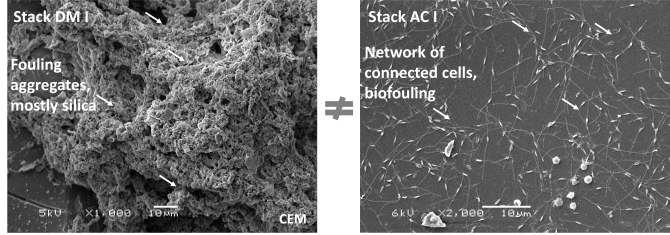
Project
Fouling and Process Design in reverse electrodialysis: a case study with real waters
To include renewable energy in the energy matrix can be a challenge for many societies. Blue energy is a promising energy source that uses the controlled mixing of the salinity gradient between river and sea water to produce electrical energy. Reverse Electrodialysis (RED) is a process that allows to harvest this energy. It uses a series of alternating anion (AEM) and cation (CEM) exchange membranes to direct ions and the membrane stack voltage is converted into an electrical current by the means of a redox reaction. This principle is represented in Figure 1. The by-product of the process is only brackish water, so it does not generate any harmful substances to the environment. The estimated salinity gradient power available globally is estimated to be between 1.4 and 2.6 TW [1].
Technological challenge
Fouling of the ion exchange membranes is known as one of the most severe problems within RED applications, since it decreases the overall power output that can be harvested. Fouling can be present in diverse ways, like organic, inorganic, biofouling and scaling, as seen on Figure 2. It is believed that for a good performance of the process, a feed water pre-treatment is necessary to inhibit fouling.

Research goals
- Identify the effect of individual foulants present in natural waters (river and sea) on RED performance,
- Identify how the foulants interact with different membranes (CEM and AEM) and how this impacts the RED process,
- Propose and test pre-treatment combinations and membrane cleaning for fouling control.
[1] Post (2009), Blue Energy: electricity production from salinitygradients by reverse electrodialysis
[2] Vermaas et al, (2013) Water Research 47 (3), 1289-1298